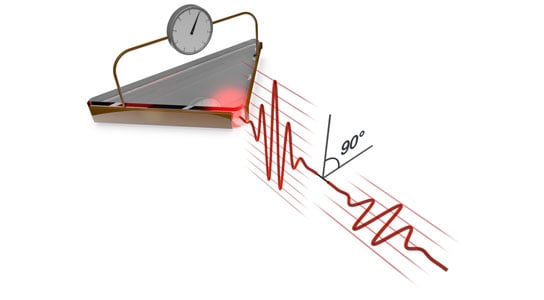
Ultrafast optoelectronic switch: A small fused silica prism that has been coated on two sides with gold electrodes is irradiated with a powerful femtosecond pulse consisting of only a few wave cycles that penetrates the prism through an only 50 nanometer wide slit between the electrodes. This first pulse increases the mobility of the electrons. The oscillations of a second, significantly weaker pulse shift the electrons toward the electrodes, which results in a measurable electrical current. When the delay between the two pulses is varied by one-half cycle of the light field (about 1.2 femtoseconds) the electrical current reverses its direction. That is an indication that the mobilization of the electrons takes place within only one femtosecond. Christian Hackenberger, LMU
A team of physicists at the Max Planck Institute have shown that ultrashort light pulses of extremely high intensity can induce electric currents in otherwise insulating dielectric materials, turning fused silica (quartz) from an insulator to a conductor and back again within quadrillionths of a second.
Semiconductor components form the backbone of all kinds of electronic equipment. The speed with which these components can switch currents on and off is one of the critical quantities for describing the power of computers, for example. The fastest silicon-based transistors presently work at clock speeds of a few billions of switching cycles per second – a single switching process thus lasts about one ten-billionth of a second. A research team lead by Ferenc Krausz, Director at the Max Planck Institute of Quantum Optics (MPQ) in Garching and head of the Attosecond Physics Lab has successfully demonstrated that, under certain conditions, ultrashort light pulses of extremely high intensity can induce electric currents in otherwise insulating dielectric materials (Nature, AOP, 5 December 2012) and the change in the materials properties can be switched on and off at ten thousand times the speed of conventional electronics.
Semiconductors owe their name to their particular property of conducting electrical current only under certain circumstances. In the normal state, they behave like insulators, i.e. they do not conduct current. However, when a small electrical voltage is applied to them, they act like conductors. The electric field transfers energy to the electrons that are bound in the ground state to their atoms and mobilizes them. Then they are able to follow an externally applied voltage and form an electrical current.
By rapidly switching the external voltage on and off, an electrical current can be switched in a semiconductor. In contrast, the electrons in insulators – also called dielectrics – are bound so tightly to the atoms that this is usually not possible.
A research team headed by Agustin Schiffrin at the MPQ irradiated fused silica (quartz glass, an insulator) with extremely brief laser pulses and thereby created such high local electrical fields in the interior of the material in which the electrons originally bound to (and held by) the atoms could be mobilized and formed a current.
Ultrashort laser pulses render dielectric conductive
The fused silica sample used in the experiment was cleaved to form a small prism with an extremely sharp tip and coated on two sides with gold, serving as electrical contacts. At the tip a tiny slit between the gold contacts permits direct access to the fused silica. The researchers irradiated the fused silica with extremely short laser pulses that consist of only about one-and-a-half cycles of the light wave. “If the pulses were longer, they would deposit so much energy into the material that it would be destroyed,” explains Tim Paasch-Colberg, the doctoral candidate working on the experiment.
Light consists of an oscillating electric and magnetic field. The extremely brief and intense pulses used in the experiments carry an electric field that increases from moderate values to more than ten billion Volts per meter extremely rapidly, within only a few femtoseconds. This field strength represents a field one hundred thousand times stronger than the field in a flash of lightning.
In their experiment, the physicists in Garching proved that the electrons were freed by this strong electric field within less than a half cycle of the laser light. This means that the insulator becomes a conductor within a mere femtosecond. “These measurements did not resolve the question of whether the conductivity can be turned off again just as fast,” says Tim Paasch-Colberg. Only this property transforms a component into a switch with which electrical signals can be controlled and processed.
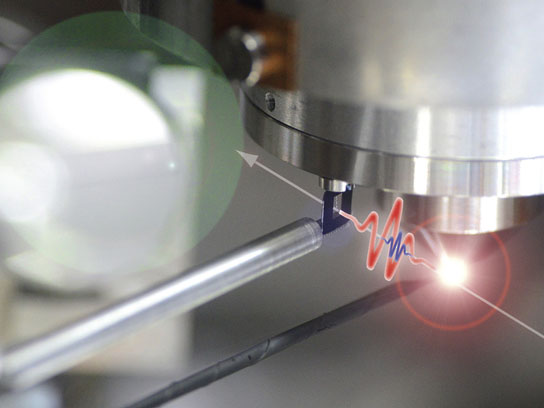
A nanometric thin silica-glass film (black frame in the center of picture) is exposed to femtosecond light pulses (red). The light pulse changes the electronic states in the glass lattice, i.e. the absorptivity of the material with each cycle of the oscillation. These fast variations can be recorded with a sequence of attosecond light pulses (blue) at different delay times with respect to the femtosecond light field. From this sequence of snap-shots, the researchers can reconstruct the influence of the light field on the material’s properties- just like in a slow-motion film. Credit: Thorsten Naeser, LMU
With attosecond pulses, the process can be recorded “in slow motion”
In a second experiment, the research team headed by Martin Schultze investigated the question of how fast the conductivity can be turned off. The physicists transformed the fused silica again from an insulator into a conductor with an ultra-short laser pulse. Then they sent a series of extremely short-wavelength UV-laser pulses of only a few tens of attoseconds in duration (an attosecond corresponds to 10-18 seconds, or a billionth of a billionth of a second) with varying time-delays through the fused silica sample and recorded by how much each of these pulses were absorbed by the material. The degree of absorption depends specifically on which of the two states – insulating or conducting – the material is in. “The technique can be compared to recording a fast process with a high-speed camera and subsequently studying it in slow motion,” explains Elisabeth Bothschafter, the doctoral candidate working on this second experiment.
The results of this second experiment proved that the modification of the insulator by the powerful light field can indeed be reversed on the timescale of a few femtoseconds. The transformation from an insulator into a conductor and back again can be arbitrarily repeated and is therefore reversible. “It was surprising for us to see that basic material properties can be changed at optical frequencies,” says Martin Schultze.
Future research will show whether fused silica can be employed in a switch operating at light frequencies. The intense ultra-short-cycle lasers necessary to achieve this are presently much too large. “We hope that these results will motivate many other labs and groups worldwide to join us in further investigations,” says Ferenc Krausz. “We would like to explore as soon as possible the feasibility of this promising development towards accelerating electronic switches to light frequencies.”
References:
“Optical-field-induced current in dielectrics” by Agustin Schiffrin, Tim Paasch-Colberg, Nicholas Karpowicz, Vadym Apalkov, Daniel Gerster, Sascha Mühlbrandt, Michael Korbman, Joachim Reichert, Martin Schultze, Simon Holzner, Johannes V. Barth, Reinhard Kienberger, Ralph Ernstorfer, Vladislav S. Yakovlev, Mark I. Stockman and Ferenc Krausz, 5 December 2012, Nature.
DOI: 10.1038/nature11567
“Controlling dielectrics with the electric field of light” by Martin Schultze, Elisabeth M. Bothschafter, Annkatrin Sommer, Simon Holzner, Wolfgang Schweinberger, Markus Fiess, Michael Hofstetter, Reinhard Kienberger, Vadym Apalkov, Vladislav S. Yakovlev, Mark I. Stockman and Ferenc Krausz, 5 December 2012, Nature.
DOI: 10.1038/nature11720

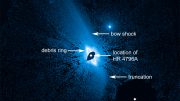

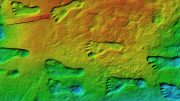

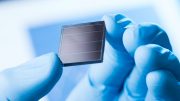


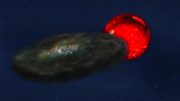
Hm as far as I understand it, you put electrons for a tiny amount of time into the conduction band via a nonlinear interaction. This gives you some conductivity. This also explains why longer pulses would destroy the material.
Nevertheless, to actually observe the effect is really astonishing – congrats to the paper!
This may give further clue on converting positive refractive index materials as negative refractive index materials using femto lasers on middle infra red using material Germanium that may give a clue on topological behaviour of disappearnce of light ray emission at negative negative refractive index regions.May be for 3D structures of cubans oscillate along convex and concave planes.
Fascinating breakthrough! Physicists inducing electric currents in insulating dielectric materials opens new possibilities for energy storage and electronics. Pushing the boundaries of materials science and electromagnetism.